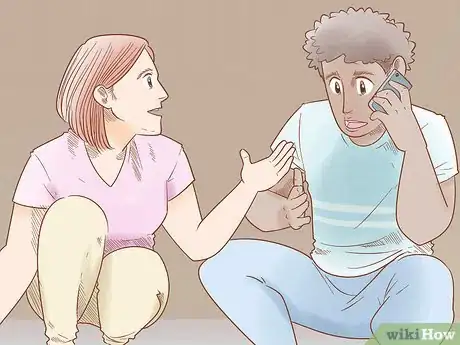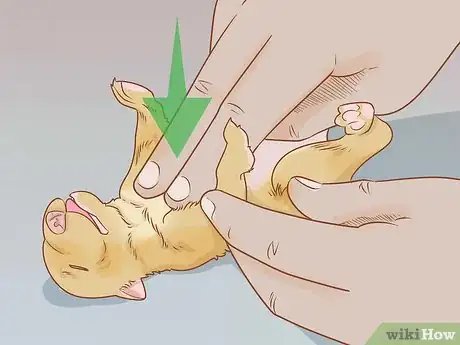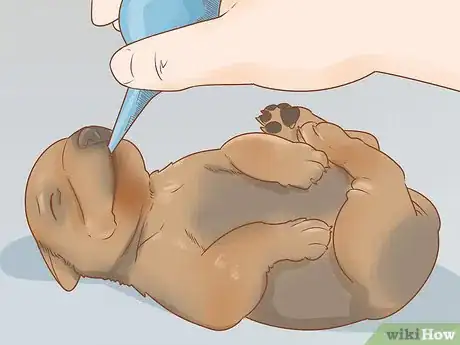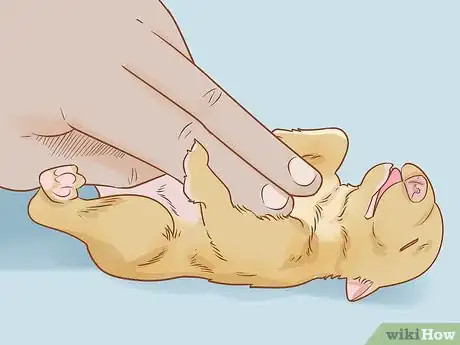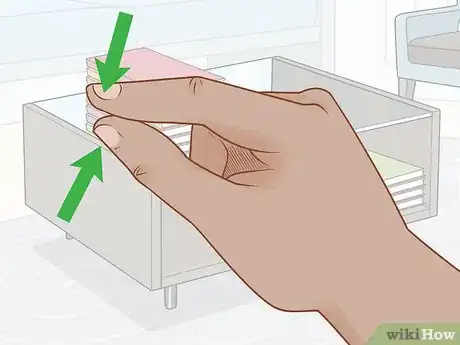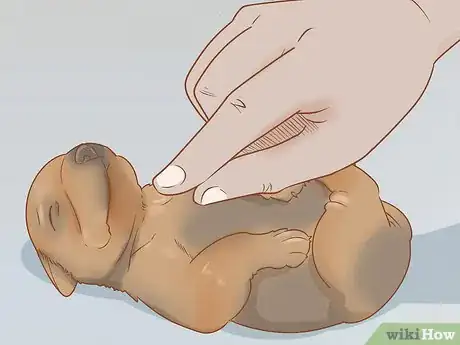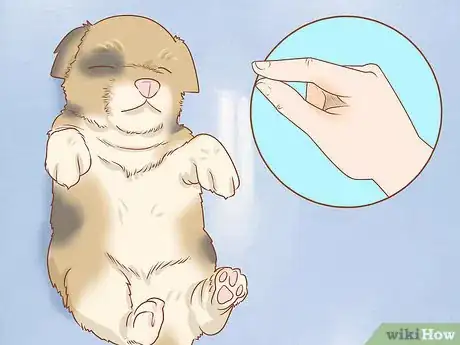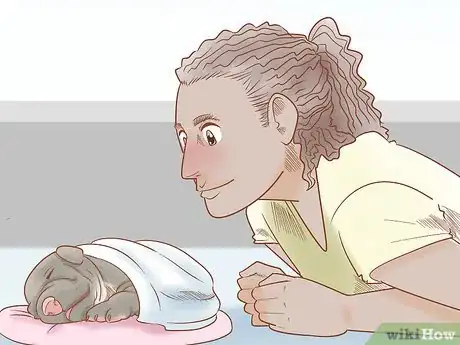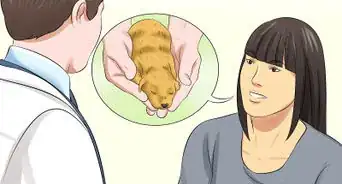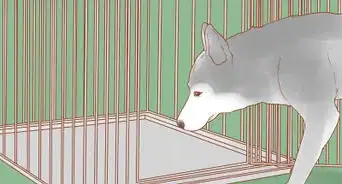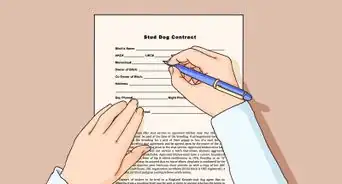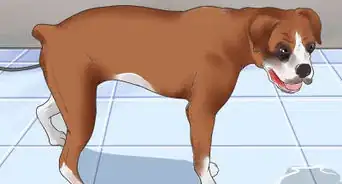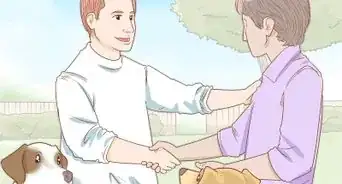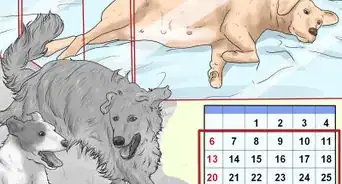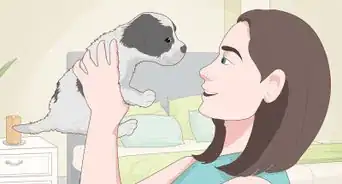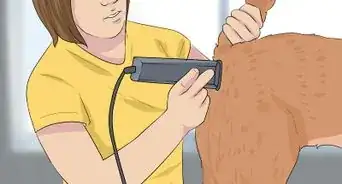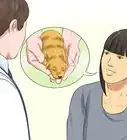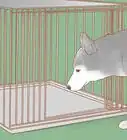This article was co-authored by Ray Spragley, DVM and by wikiHow staff writer, Christopher M. Osborne, PhD. Dr. Ray Spragley is a Doctor of Veterinary Medicine and the Owner/Founder of Zen Dog Veterinary Care PLLC in New York. With experience in multiple institutions and private practices, Dr. Spragley’s specializations and interests include non-surgical management of cranial cruciate ligament tears, Intervertebral Disk Disease(IVDD), and pain management in osteoarthritis. Dr. Spragley holds a BS in Biology from SUNY Albany and has a Doctor of Veterinary Medicine degree (DVM) from Ross University School of Veterinary Medicine. He is also a Certified Canine Rehabilitation Therapist (CCRT) through the Canine Rehab Institute as well as a Certified Veterinary Acupuncturist (CVA) through Chi University.
This article has been viewed 127,289 times.
Some puppies are unable to start breathing on their own immediately after birth. In other cases, a puppy beyond newborn stage may become unresponsive due to illness or injury. In either situation, a quick response on your part greatly improves their chances of recovery. The process for assessing if a puppy needs emergency cardiopulmonary resuscitation (CPR), and the care procedures after revival, are the same no matter their age. However, actually performing rescue breathing and chest compressions on a puppy varies a bit based on whether they’re newly-born or not.
Steps
Assessing a Puppy and Calling for Help
-
1Check for signs that an unresponsive puppy is breathing. Look at its chest for movement, listen for breathing sounds, and put your cheek near its face to feel for breathing. If the puppy is gasping or breathing very weakly or irregularly, treat it as if it is not breathing at all.[1]
- When a puppy does not immediately begin to cry after birth, there is a good chance that it may not be breathing.
- Breech birth puppies—those that are born feet-first, rather than head-first—are more likely to face danger than those birthed normally.
- Even a puppy born normally may not immediately begin breathing, though. Any puppy that does not begin breathing within a few seconds of birth should be given emergency CPR.
-
2Instruct another person to call the veterinarian. That way, you can focus on immediately starting CPR procedures. The veterinarian can relay guidance over the phone.[2]
- If you are the only person around, perform emergency CPR for at least 5 minutes (or until the puppy responds) before contacting the veterinarian. Once the puppy starts breathing, call the veterinarian for advice on continued care.
Advertisement -
3Start with either emergency breathing or chest compressions. For a newborn puppy that isn’t breathing (regardless of whether it has a pulse), start by clearing the airway and doing emergency breathing, then move onto chest compressions if there is no pulse. For an older puppy, your first move will depend on the specific circumstances:[3]
- If the non-newborn puppy has no pulse, plan to start with chest compressions.
- If the older puppy has a pulse but isn’t breathing, you’ll start by clearing the airway and giving rescue breathing.
Resuscitating a Newborn Puppy
-
1Drain the puppy’s airway using gravity. In many cases, a puppy is born unresponsive because its airway is blocked by fluids. First, use a clean towel or washcloth to wipe away any fluid or membranes from the puppy's mouth and nose. Then, gently hold the puppy's head downward for 5 to 10 seconds so that gravity can help drain any amniotic fluid and/or mucus from the mouth, throat, and lungs.[4]
- Centrifugal force can also be used to drain the fluid from the puppy's lungs, but you need to ask a veterinarian to demonstrate the process before attempting it. You'll need to hold the puppy's head and neck very secure while smoothly swinging the puppy down and in between your legs. The movement should not be jerky and you must ease the puppy into a gradual stop.[5]
- Keep in mind that you should only use centrifugal force as a last resort and be very careful, because too much force can cause brain damage.
-
2Remove remaining airway fluid using a suction bulb syringe. While keeping the puppy's head tilted downward, use a medical suction bulb syringe to remove fluid from the puppy's mouth.[6]
- Before inserting the syringe into the puppy’s mouth, squeeze the bulb to remove the air from inside it.
- Insert the tip of the suction bulb into the puppy's mouth. The tip should reach the back of the puppy’s mouth, but don’t force it too far into the throat, since doing so could cause injury to the puppy's airways.
- Once the syringe is positioned, gradually release the squeezed bulb. The suction should draw fluid from the mouth and throat into the bulb.
- Remove the bulb from the puppy's mouth and squeeze it again to evacuate fluid and air. Repeat two or three more times, or until you stop drawing fluid out.
-
3Put your mouth over the puppy’s mouth and nose. Place the puppy on its back. Position your mouth so that it is sealed around both the mouth and nose of the newborn puppy. Alternatively, if it’s a larger newborn, you can hold the puppy's mouth closed with your hand while positioning your own mouth over the puppy's nose.[7]
- Making mouth-to-mouth contact opens up the possibility of the puppy transmitting illnesses like brucellosis to you. The odds are low that you’ll develop any type of serious illness from a puppy, but you’ll have to decide for yourself what amount of risk you’ll accept in order to potentially save the puppy’s life.
-
4Breathe into the puppy's nose and mouth. Gently breathe into the puppy's nose and mouth 2 or 3 times to fill its lungs with air. Depending on your positioning, you can either use your eyes or hand to confirm that the puppy’s chest is raising slightly with each breath you give.[8]
- Breathe small, gentle puffs of air into the puppy. The amount of breath needed to blow out a match may be sufficient. Do not breathe too deeply, since doing so can damage the puppy's tiny lungs.
- If the chest isn’t moving, the puppy’s airway is probably still blocked. Try to clear it with the bulb syringe again.
-
5Check for a pulse once you’ve given 2-3 breaths. After administering initial respiratory treatment, check the puppy's chest for a heartbeat. This should be the first time you’ve checked the newly-born puppy for a pulse.[9]
- Place the first two fingers of one hand against the chest wall, at or just below the armpits of the front legs. A strong heartbeat should be easy to identify with no additional tools.
- You may need to use a stethoscope to identify the difference between a weak heartbeat and no heartbeat, however. If you have a stethoscope, place it over the chest wall and listen for a few seconds. If you don't have a stethoscope and can't feel a heartbeat, assume there isn't one.
- Note that a normal, healthy newborn puppy should have a heartbeat between 120 and 180 beats per minute. Use a clock or stopwatch to see if the heart is beating 2-3 times per second.
-
6Position your thumbs and forefingers for chest compressions. If the puppy’s heart is not beating, you will need to perform a few gentle chest compressions to circulate blood and hopefully restart the heart. The puppy should still be positioned on its back.[10]
- Visualize where the bent elbows of the puppy’s front legs would touch the sides of its chest, or even position the legs this way to be sure. You’ll place your thumbs and forefingers in these positions.
- Place both of your forefingers on one side of the chest, and both of your thumbs on the other side.
-
7Give chest compressions with your fingers for 15–20 seconds. Squeeze the chest quickly with your thumbs and forefingers to stimulate the heart. Squeeze firmly enough to move the ribcage, but don’t use full force or you’ll cause further damage.[11]
- Since an average newborn puppy has a pulse of 120-180 beats per minute, you’ll want to do compressions in quick succession. Use the beat of a popular song to guide you—for instance, “Harder to Breathe” by Maroon 5 (150 bpm); “We Got the Beat” by the Go-Go’s (152 bpm); or “Pressure” by Billy Joel (148 bpm).[12]
-
8Repeat both respiratory and cardiac treatments as needed. You will need to switch between mouth-to-mouth resuscitation and chest compressions until the puppy shows signs of life.[13]
- Give the puppy 2-3 puffs of air every 15 to 20 seconds.
- Continue to gently compress the puppy's chest rapidly in between puffs of air.
- Check the puppy every minute to determine if it has begun to breathe on its own. You should also check for a heartbeat every minute.
- If there is no response after 5 minutes, it’s very unlikely the puppy can be revived.
Resuscitating a Puppy Past Newborn Stage
-
1Determine if you need to start with rescue breathing or chest compressions. If the puppy doesn’t have a pulse, start with chest compressions whether it is breathing or not. (Skip ahead to the step below that deals with starting chest compressions.) If the puppy has a pulse but isn’t breathing, clear the airway and start rescue breathing.[14]
- To check for breathing, look at the chest, listen for breathing sounds, and feel for exhaled breaths with your cheek.
- To check for a pulse, put your first two fingers of one hand on the center chest, just at or below the armpits of the puppy’s front legs. If you have a stethoscope, listen with it instead.
-
2Check for obstructions and clear the airway. Stick your pinky into the puppy’s mouth to check for an airway obstruction. If you feel one, sweep it out of the mouth with your pinky. If blood or mucus is blocking the airway, squeeze a bulb syringe, place it into the back of the puppy’s mouth, and let go of the bulb to suck out the fluid.[15]
- If the puppy’s tongue is in the way, gently pull it outward so you have access to the mouth.
-
3Close the dog’s mouth and make a seal over its nose. Place the dog on its back, then cup one hand under its chin and push its lips together with your fingers. With your other hand, complete a sealed tube around the puppy’s nose.[16]
- Your breaths will go through this hand-tube and into the puppy’s open nose.
- If the puppy’s face is still to small for this maneuver, simply place your mouth over its mouth and nose and make a seal.
-
4Give breaths every 6 seconds for a minute. Breathe into your cupped hands forcefully enough to raise the puppy’s chest, but not so forcefully that you cause damage to its lungs. This will take a bit of guesswork and trial-and-error based on the dog’s size, so start gently and blow harder as needed.[17]
- If the dog isn’t breathing on its own after a minute, pause and check that it still has a pulse. If so, resume breathing for another minute, and repeat as needed. If not, start chest compressions.
-
5Position the dog and your hands for chest compressions. For a small puppy, keep it on its back and place your two forefingers on one side of its chest, and your two thumbs on the other side. They should be positioned where the puppy’s bent front elbows would touch its ribcage.[18]
- If the puppy is too big to span your hands across its chest, place it on its right side. Place one palm flat on the side of the chest, where the bent front elbow would touch on that side. Overlap your other palm over the first one.
-
6Compress the chest once per second for 6 seconds. Squeeze or press down hard enough so that you can feel and see the chest compress, but don’t use excessive force. Use a clock or stopwatch, or just count the “One Mississippi, Two Mississippi” method in your head.[19]
-
7Give a breath, then return to compressions. Close the puppy’s mouth and create a tube with your hands to breathe through into the dog’s nose. (Refer to the step above on giving breaths if you haven’t already done this.) Give a quick breath, then resume compressions for another 6 seconds until the dog responds.[20]
- Every minute, stop briefly and check for breathing and a pulse.
- After 5 minutes, it’s very unlikely the puppy will survive.
Stimulating and Aiding a Revived Puppy
-
1Stimulate the puppy once it shows signs of life. As soon as the puppy's heart begins to beat, stop performing chest compressions and focus on stimulating the puppy. Continue giving breaths if its breathing is not yet regular and strong.[21]
- Using light, careful pressure, vigorously rub the puppy with a towel.
- Gently turn the puppy over in your hands several times.
- If it’s a newborn or still very small, grab the puppy by the scruff of its neck several times as well.
- While stimulating the puppy, you may still need to provide a few puffs of air every 20 to 30 seconds to keep its lungs pumping.
-
2Keep stimulating the puppy for at least 20 minutes. Once the puppy's heart starts beating, you should continue rubbing and turning the puppy in your hands for at least 20 minutes.[22]
- Most puppies that revive after receiving emergency CPR will stabilize after 20 minutes.
- If the puppy's heart does not start beating within 5 minutes of treatment, however, it is unlikely that the puppy will revive.
-
3Monitor the puppy closely. All newborn puppies should be closely monitored for several days, but it is especially important to keep a close eye on puppies who needed to be revived upon birth.[23]
- One of the most important things you can do is keep the puppy warm. Puppies that get chilled during the first week of life can easily weaken and die. Provide hot water bottles, heating pads, heating lamps, and plenty of warm blankets in an effort to keep the box it stays in at a minimum constant temperature of 85 °F (29 °C).
- Professional veterinary care is also strongly recommended. If you have not already called the veterinarian, do so after the mother has given birth to the remainder of her puppies. Let the veterinarian know about any puppies you needed to revive and follow their instructions on additional aftercare.
Things You'll Need
- Suction bulb syringe
- Stethoscope (optional)
- Hot water bottles, heating pads, heating lamps, and blankets
References
- ↑ https://carrington.edu/blog/veterinary/how-to-give-a-puppy-cpr/
- ↑ https://www.petcoach.co/article/cpr-in-newborn-puppies/
- ↑ https://www.cprcertified.com/blog/revive-a-pet-with-cpr-yes-its-possible-heres-how
- ↑ https://www.petcoach.co/article/cpr-in-newborn-puppies/
- ↑ http://www.dogbreedinfo.com/whelping.htm
- ↑ https://carrington.edu/blog/veterinary/how-to-give-a-puppy-cpr/
- ↑ https://www.petcoach.co/article/cpr-in-newborn-puppies/
- ↑ https://carrington.edu/blog/veterinary/how-to-give-a-puppy-cpr/
- ↑ https://carrington.edu/blog/veterinary/how-to-give-a-puppy-cpr/
- ↑ https://www.cprcertified.com/blog/revive-a-pet-with-cpr-yes-its-possible-heres-how
- ↑ https://www.petcoach.co/article/cpr-in-newborn-puppies/
- ↑ https://jog.fm/popular-workout-songs?bpm=150&genre_id=pop
- ↑ https://carrington.edu/blog/veterinary/how-to-give-a-puppy-cpr/
- ↑ https://carrington.edu/blog/veterinary/how-to-give-a-puppy-cpr/
- ↑ https://carrington.edu/blog/veterinary/how-to-give-a-puppy-cpr/
- ↑ https://carrington.edu/blog/veterinary/how-to-give-a-puppy-cpr/
- ↑ https://carrington.edu/blog/veterinary/how-to-give-a-puppy-cpr/
- ↑ https://carrington.edu/blog/veterinary/how-to-give-a-puppy-cpr/
- ↑ https://carrington.edu/blog/veterinary/how-to-give-a-puppy-cpr/
- ↑ https://carrington.edu/blog/veterinary/how-to-give-a-puppy-cpr/
- ↑ https://carrington.edu/blog/veterinary/how-to-give-a-puppy-cpr/
- ↑ https://www.petcoach.co/article/cpr-in-newborn-puppies/
- ↑ https://carrington.edu/blog/veterinary/how-to-give-a-puppy-cpr/
About This Article
To revive a puppy, check for signs that it’s breathing, like chest movements or breath sounds. If you can’t detect breathing, have another person call the veterinarian so you can focus on CPR. However, if you’re the only person present, perform CPR for 5 minutes before calling the vet. For a newborn puppy, use a towel to wipe away any fluid from its mouth and nose. Then, hold the puppy upside down for 10 seconds to drain any amniotic fluid from the mouth or lungs, which you can finish removing with a bulb syringe. Next, put your mouth over the puppy’s mouth and nose, and gently breath 2 or 3 times to fill its lungs with air. If the puppy still doesn’t have a pulse, place your thumbs and forefingers on its chest for 20 seconds of compressions. For more tips from our Veterinary co-author, including how to resuscitate a puppy past the newborn stage, keep reading!

